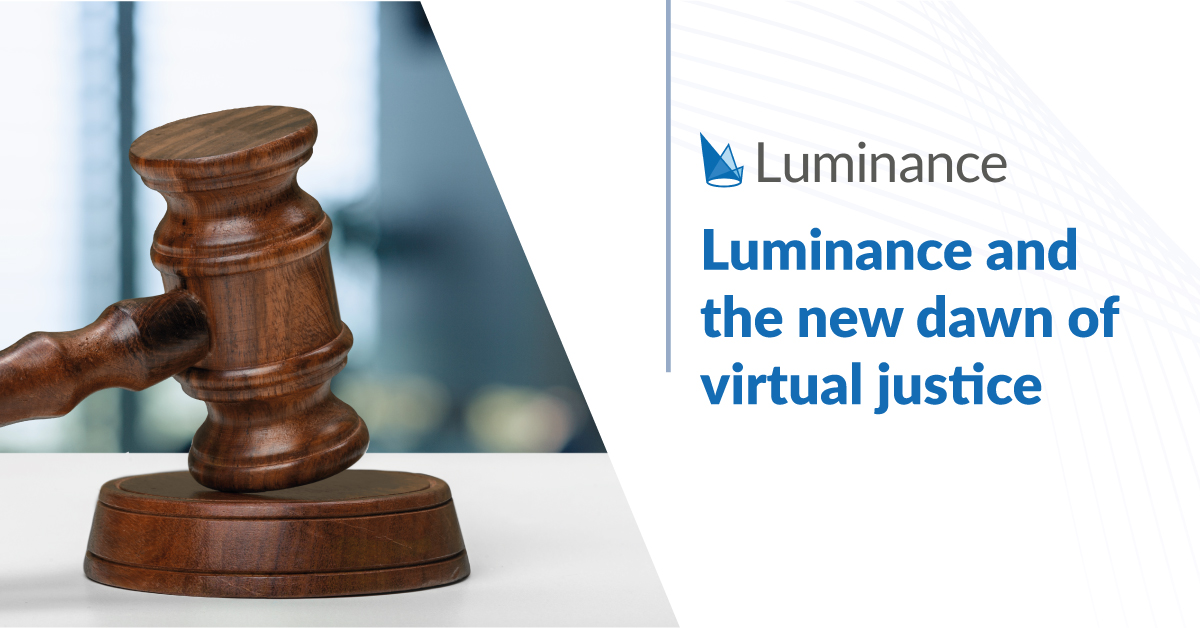
Blog
Luminance and the new dawn of virtual justice
9 July 2020 | Luminance
The novel coronavirus has kickstarted the digital transformation of the courtroom. Besides the switch to video-conferencing, lawyers are embracing revolutionary technology such as machine learning to streamline and automate conventional court work, from the identification, collation and exchange of data to its review and production. Luminance’s cutting-edge eDiscovery software is leading the charge with a robust solution that allows legal counsel to prepare for court cases with unmatched efficiency and speed, all whilst gaining total insight into what is within their dataset.
Managing huge datasets
Manually wading through piles of physical documents is no longer feasible or even sustainable for lawyers. Take criminal investigations as an example- the ubiquitous nature of mobile devices in our daily lives is allowing these planning and execution of these types of crimes to become incredibly electronically sophisticated, in turn creating an unlimited source of evidence.
This was recently highlighted by leading London barristers’ chambers, The 36 Group, who needed to review over 10,000 documents for a high-profile murder investigation. Whilst previously, the London-based set had relied on using the ‘Crown Court Digital Case System’ (CCDS), a web-based platform used to access, prepare and present information for court proceedings, the defence team soon became aware that the system was unable to meet their legal needs. Instead, by deploying a unique blend of supervised and unsupervised machine learning algorithms, Luminance provided The 36 Groups’ 20-person team with an immediate and graphic visualisation of the entire dataset, allowing the lawyers to quickly and easily find crucial documents such as evidence, unused material, correspondence and media evidence. This was further enhanced by Luminance’s powerful data culling and filtering functions, enabling the team to cut through irrelevant data at record speed whilst also ensuring that no stone was left unturned.
Seamless remote collaboration
The sudden need to work remotely has fundamentally altered all of our working processes, not least the work of judges, arbiters and barristers. With the majority of hearings now taking place via video-conferencing and telephone, having a platform in place which allows judges and lawyers to access information remotely and collaborate in real time is vital.
For instance, in The 36 Group’s recent review, the team comprised not only of barristers but a multitude of forensic experts as well as former police officers. Luminance’s easy cloud-deployment and collaboration tools such as the ability to allocate documents and tasks and track work progression ensured that the team were able to conduct a seamless review despite working remotely. Moreover, as an intuitive and easy-to-use platform, users do not require intensive training and are able to get up-and-running almost immediately – this was of critical importance given that some team members were less familiar with the use of technology to review cases, and could not receive in-person training due to remote working policies. As Rowan Caffull, The 36 Group’s Chief Operating Officer, notes: “Luminance is a tool which could be adopted by every member of the team, from silk and junior to instructed experts.”
The move to a paperless justice system
The requirement that hard copy trial bundles are replaced with electronic bundles or ‘e-bundles’, is one of the many new court requirements in the wake of Covid-19. As it stands, there are huge time and cost inefficiencies in producing, transporting, and storing such quantities of paper required for a court hearing; relying on a paper-based system also always runs the risk that material might go missing. Moreover, when new material or additional evidence comes to light, it’s incredibly difficult to move pages.
Tools like Luminance are empowering lawyers to streamline this time and resource-intensive process. Most recently, Dublin-based law firm, OBH Partners, used Luminance’s powerful document production tools to create, modify and finalise trial bundles ahead of a virtual hearing at the Supreme Court. Using Luminance, OBH Partners were able to immediately ‘zero-in’ on exactly what material they wished to include in the production. Not only that, by integrating with Microsoft Word, Luminance can automatically hyperlink all production references in Word to their original document. This ‘live’ Word document can be shared with colleagues or opposing counsel, who can click on the hyperlink and instantly be taken to the correct document in Luminance.
Driving the change
The uptake in remote in courts is forcing many lawyers to rethink the way that they work. Luminance’s pioneering solution is able to cater to every legal need, supporting lawyers at the early stage of a review with AI-powered Early Case Assessment right through to document creation and production. Whilst it is unclear what the future of virtual courts are, it is certainly apparent is that the use of tech is not simply keeping the wheels of justice turning amid the pandemic – access to technologies such as Luminance underpins the justice system of tomorrow.